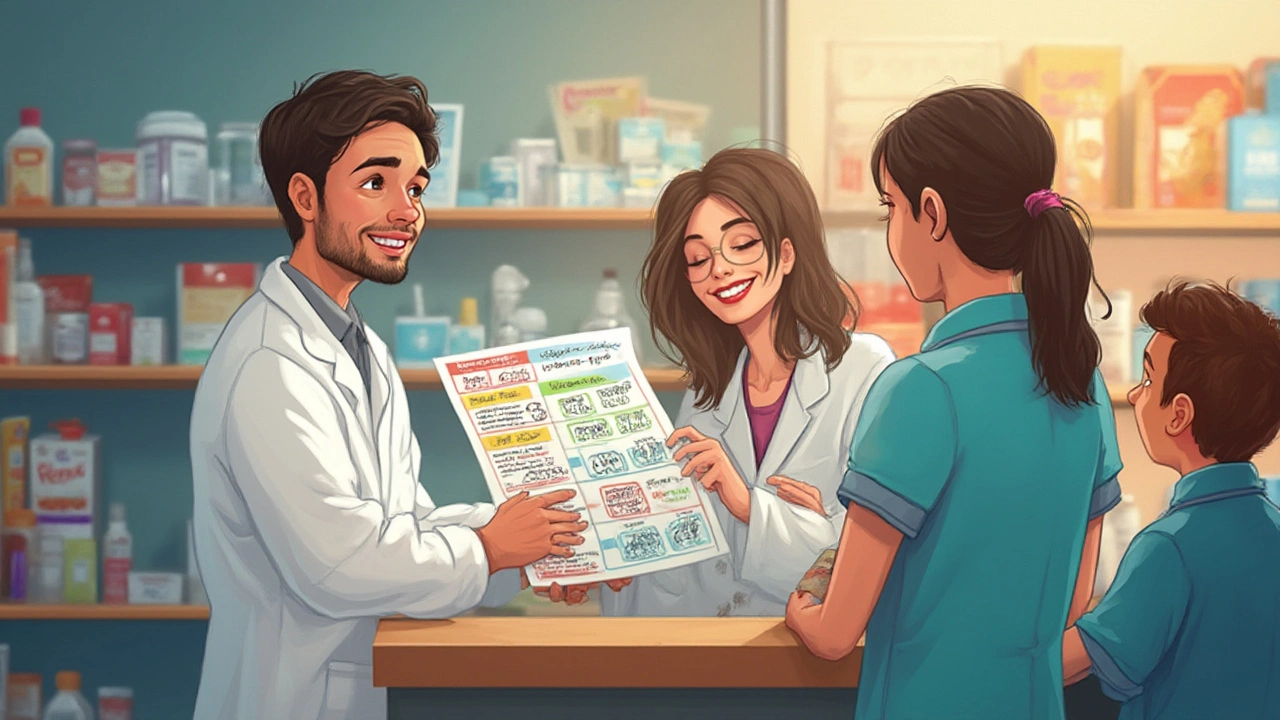If you’ve ever held a receipt from the pharmacy and wondered if you just bought gold-plated Lipitor, you’re not alone. Drug prices in the U.S. can hijack your wallet faster than the bill after a six-course steak dinner. GoodRx took off by broadcasting all those hidden pharmaceutical discounts, helping millions to save. But they aren’t the only game in town anymore. The rush to make prescriptions affordable has attracted a new wave of contenders, each hustling with a different angle to help you dodge sticker shock at the register. Here’s what’s really happening behind those big yellow price tags—and seven companies fighting hard for your next prescription fill.
The Rise of Prescription Discount Programs
Prescription savings programs exploded over the last ten years as Americans got fed up with unpredictable, sky-high drug costs. Many people don’t realize this, but retail pharmacies don’t have fixed pricing for medications. Instead, prices can vary wildly, even at the same store, based on insurance contracts, manufacturer deals, and secretive middlemen called pharmacy benefit managers (PBMs). That’s where prescription discount companies swoop in. They negotiate bulk deals, create coupons, and leverage pharmacy competition—all to drive down what you pay.
GoodRx blew up this world by making those discounts transparent and easy to find for everyone. The concept is dead simple: type in your drug, compare prices at local pharmacies, print or text yourself a coupon, and save—often beating your insurance copay. But as more companies noticed how broken these prices were, they realized there was room to compete, innovate, and sometimes outdo GoodRx in certain meds or markets.
The competition is fierce, and here's a fun stat: Back in 2023, Americans with no insurance—or those with high-deductibles—found over $9 billion in prescription savings using discount cards like GoodRx and its competitors, according to a report by the Pharmaceutical Care Management Association. That’s more than the GDP of some small countries, just from shaving down retail drug costs. These newer players in the space are pushing the boundaries even further—sometimes negotiating better rates on specific generics, adding extra user rewards, or even letting you order meds online for home delivery at a deep discount.
How Discount Companies Negotiate with Pharmacies
It might surprise you, but the savings you get from these cards aren’t magic—there’s a whole negotiation going on behind the curtain. Most companies like GoodRx work closely with PBMs, which act a bit like wholesalers for medications. PBMs agree to steer more customers to a certain pharmacy in exchange for lower prices on popular medications. The discount company then splits part of that savings with the pharmacy, and the rest makes its way to your bill.
Some newer companies go even further. A few of them, like Mark Cuban’s Cost Plus Drugs, skip middlemen when possible. They negotiate directly with drug manufacturers and offer a simple markup—sometimes as low as 15% above wholesale. Others create closed networks of only partner pharmacies and pledge to send traffic their way for even bigger concessions on price. Still, a couple operate entirely online, buying huge volumes of generic meds, storing them in their own facilities, and mailing them to your door.
Why do pharmacies play along? Simple—foot traffic and customer loyalty. Pharmacies have slim margins on most drugs, but they’ll eat a slimmer margin if it means you might pick up a bottle of shampoo, batteries, or a candy bar while grabbing your prescription. Some discount companies also offer pharmacies small cash incentives each time a coupon gets used, sweetening the deal. But don’t assume all discounts are alike. It pays to comparison shop, because discounts for the same medication at the same pharmacy can vary by which discount card you use. Smart shoppers rotate between a few different companies for the best savings, especially for generic drugs or maintenance meds you refill regularly.
7 Companies Competing with GoodRx for Lower Drug Prices
Ready to meet the new faces fighting for your savings?
- SingleCare – This company is everywhere, and their deals can beat GoodRx on certain medications. SingleCare partners with more than 35,000 U.S. pharmacies and stands out because they negotiate directly with pharmacies, not PBMs, letting them sometimes carve out deeper discounts. My buddy tried comparing their prices for his cholesterol meds and shaved an extra $10 off his usual bill. Plus, SingleCare runs a loyalty program—if you use them consistently, you rack up savings that can really add up.
- Cost Plus Drugs (Mark Cuban’s pharmacy) – Here’s where things get spicy. Mark Cuban’s shop has disrupted things by selling over 1,000 common meds at drastically lower prices. Cost Plus buys directly from manufacturers, shows you their markup, and mails meds to your door. Think amoxicillin for $4 instead of $30. They don’t work with insurance or coupons, so you always see the real price up front. Not everything’s covered, but for generics or chronic scripts, it’s a slam dunk.
- RxSaver – RxSaver isn’t new, but they've reinvented themselves post-pandemic. They offer price comparisons right in Google search results (type your drug, see instant deals), and their pharmacy network is huge—more than 60,000 locations. They also have a neat feature where you can set price alerts for your upcoming refill and jump on a lower price when it pops up. RxSaver shines on maintenance meds and offers frequent promo deals for first-time users.
- Amazon Pharmacy – If you have Prime, you can access Amazon Pharmacy’s Prescription Savings Benefit for major discounts. Amazon negotiates with PBMs and manufacturers to set highly aggressive pricing, and their mail-order operation is a gift for anyone who loathes waiting in line. Their interface is clean—add your insurance, see if going with the Amazon price card is cheaper, and even automate refills. For generic meds, prices can reach shockingly low levels.
- WellRx (ScriptSave) – What makes WellRx interesting is their focus on health tracking and education alongside savings. They partner with over 65,000 U.S. pharmacies and sometimes cut below even GoodRx savings. Their mobile app stands out—it lets you track medication schedules, get reminders, and even scan barcodes at the store for instant price lookup. They’re also big on educating users about pill interactions, so you can check safety while saving cash.
- Blink Health – This one works a bit differently. Blink lets you prepay for prescriptions online, then pick up your order at the pharmacy or get it delivered. They claim to cut out PBMs for most deals and set flat-rate pricing for hundreds of generic meds. Blink shot to fame by offering insulin at a fraction of the U.S. list price. If you prepay, the price is locked in—no surprises at pickup. They’re a scavenger hunter’s dream for generics but don’t always cover every branded drug.
- ScriptAssistRx – While not as heavily advertised as others, ScriptAssistRx has quietly grown through major employer partnerships and doctor referrals. They focus on negotiating custom drug bundles for chronic conditions—like diabetes or hypertension—with discounts achieved by steering customers to their specific pharmacy partners. Their user portal is heavy on medication literacy, and some people get free home delivery if they refill regularly. It’s quietly revolutionizing savings for folks managing multiple monthly scripts.
If you’re keeping track, a few other honorable mentions include NeedyMeds, Easy Drug Card, and America’s Pharmacy—all with unique offerings in niche markets. But these seven lead the charge when it comes to punching holes in sky-high prescription prices for everyday shoppers and families.
For a deeper breakdown of discounts, features, and user experiences with companies like GoodRx, check out this comparison I found useful when helping my neighbor with her prescriptions last winter.

Comparing the Savings: Where Each Company Shines
Not every competitor dominates in all drug categories. The best strategy isn’t picking a single company, but mixing and matching to suit your specific meds, pharmacy, and insurance situation. Here’s a quick table showing where each one tends to excel based on user reviews and public data:
| Company | Strongest For | Average % Savings (Select Meds) | Home Delivery? |
|---|---|---|---|
| GoodRx | Brand & Generic, major retail chains | Up to 80% | No (coupons only) |
| SingleCare | Generics, frequent users, loyalty program | Up to 80% | No |
| Cost Plus Drugs | Generics, bulk refills | Up to 90% | Yes |
| Amazon Pharmacy | Prime members, mail order | Up to 85% | Yes |
| WellRx | Seniors, chronic meds, mobile app users | Up to 80% | No |
| Blink Health | Pre-pay customers, diabetes drugs | Up to 85% | Yes |
| ScriptAssistRx | Chronic conditions, bundled meds | Custom savings | Sometimes |
Here’s a tip direct from my own medicine cabinet: Before each refill, I check both GoodRx and at least two rivals from the list above. For my wife Eliza’s migraine prescription, we actually found that SingleCare consistently beat GoodRx by $12—enough for a coffee date. But for my seasonal allergies, Amazon Pharmacy had the lowest out-of-pocket price and got it to my door in three days. There’s no single winner, so arm yourself with a few account sign-ups and rotate based on what your medications cost result by result.
Navigating the Fine Print: Tips for Getting the Best Price
Drug pricing is rarely as clear-cut as typing a code into a website. There are a handful of rules and tricks to maximize your savings every time you fill a script.
- Compare before every refill. Prices move, even monthly, based on bulk deals and pharmacy stock. Never assume last month’s discount is still the best.
- Don’t be afraid to switch pharmacies. Even pharmacies on the same street can have a $20 difference for the same discount card.
- Inspect your prescription. If your doctor writes for a 90-day fill, you might get a better per-pill price versus a 30-day. Ask if you can get a longer supply.
- Stack rewards for repeat fills. Companies like SingleCare and RxSaver sometimes offer rebates or loyalty perks for multiple redemptions.
- Look for digital coupons or app-only deals. Blink Health, for instance, has promo codes for first orders. Amazon sometimes applies automatic coupons for new users.
- Check for free home delivery. If you use Cost Plus or Amazon Pharmacy for something you refill regularly, delivery can save both cash and trips.
- Be careful with branded (name-brand) drugs. Discounts work best for generics. Branded drug savings vary—and sometimes your insurance copay will actually be lower. Always double-check both options.
- Know when to use insurance. Sometimes the GoodRx competitors beat your insurance, but sometimes they don’t. Pharmacies must process one transaction per fill, so ask them to run both prices, but not to combine them.
- Consider manufacturer coupons and patient assistance programs if you’re denied discounts. NeedyMeds and the Partnership for Prescription Assistance are lifelines for those who qualify.
This all sounds like work, but the payoff can be huge. A friend of mine saved nearly $400 of her annual medication costs just by checking her prices three times a year.
What’s Next for Prescription Savings?
The arms race for lower drug prices isn’t slowing down. One thing to watch: Big-box stores and chain pharmacies, like Walmart and Costco, are rolling out their own savings programs, sometimes beating the discount app prices if you’re a member. Employers and state governments are also getting craftier about steering employees to certain pharmacies in exchange for big rebates. Telemedicine pharmacies, thanks to pandemic and post-pandemic trends, are claiming a bigger slice of the market, especially for medications that don’t need a physical visit or very quick turnaround.
Regulators are sniffing around, too. The FTC and other agencies have started to question how PBMs and discount card companies split savings, hoping that new laws might squeeze extra value out for patients. The secret sauce will stay secret for a while longer, but expect watchdogs to push for even more transparency—meaning better tools for you to see real retail prices before you fill a script. And keep an eye on up-and-coming tech startups bringing AI-powered price shopping (think Hopper for hotel rooms, but for your heartburn meds).
One thing’s certain: the next time you’re quoted $140 for a generic, don’t just sigh and swipe your card. Someone out there is probably offering it for $12—you just need the right search, the right discount network, and a bit of stubbornness. Compare, double-check, and treat those price tags like you would a sticky gas station sushi roll: with lots of skepticism and your phone handy for research.



6 Comments
Emmalee Amthor
July 25, 2025 AT 01:44i just checked my insulin price on goodrx and it was $400. then i tried cost plus drugs and it was $12. i cried. not from sadness, from relief. why does america make us play drug price roulette just to stay alive? this isn’t healthcare, it’s a casino run by vultures.
Leslie Schnack
July 26, 2025 AT 22:02wait, so if i use singlecare for my blood pressure med and blink for my antidepressant, and amazon for my allergy pills-am i technically a drug price hacker? because i feel like i just graduated from the school of survival. also, rx saver’s price alerts saved me $67 last month. small wins, people.
Saumyata Tiwari
July 28, 2025 AT 16:33how pathetic. you americans are so obsessed with discount coupons like they’re some kind of moral victory. in india, we don’t need apps to tell us drugs are expensive-we just accept it. your entire system is a farce built on corporate greed and consumer delusion. at least we don’t pretend capitalism can be fixed with a loyalty program.
Anthony Tong
July 29, 2025 AT 19:26Let me be perfectly clear: this entire ecosystem is a coordinated deception orchestrated by pharmacy benefit managers, tech startups with venture capital backing, and the federal government’s deliberate inaction. The $9 billion in ‘savings’ you cite? That’s not savings-it’s a redistribution of wealth from patients to middlemen who’ve been granted legal monopolies. Every discount card is a Trojan horse. The real cost is your autonomy. You think you’re saving money? You’re being groomed for a subscription-based healthcare dystopia where your body is a data point and your prescriptions are a loyalty reward. Wake up.
Roy Scorer
July 30, 2025 AT 14:16you all act like you’re heroes for comparing prices like it’s some kind of virtue. but let’s be real-you’re not fighting the system, you’re just playing its game better. you’re not saving lives, you’re just avoiding bankruptcy long enough to keep scrolling. meanwhile, the people who can’t afford to spend 45 minutes comparing apps? they’re just dying quietly. and you’re patting yourselves on the back for finding a $12 coupon. pathetic. you think you’re clever? you’re just the kind of person who’ll sell your soul for a discount on metformin.
Marcia Facundo
July 31, 2025 AT 01:44my mom used to cry when she had to choose between her meds and groceries. now she uses singlecare and amazon pharmacy. she says it’s not a win-it’s just not losing as fast. i’m glad these apps exist, but i hate that they had to.